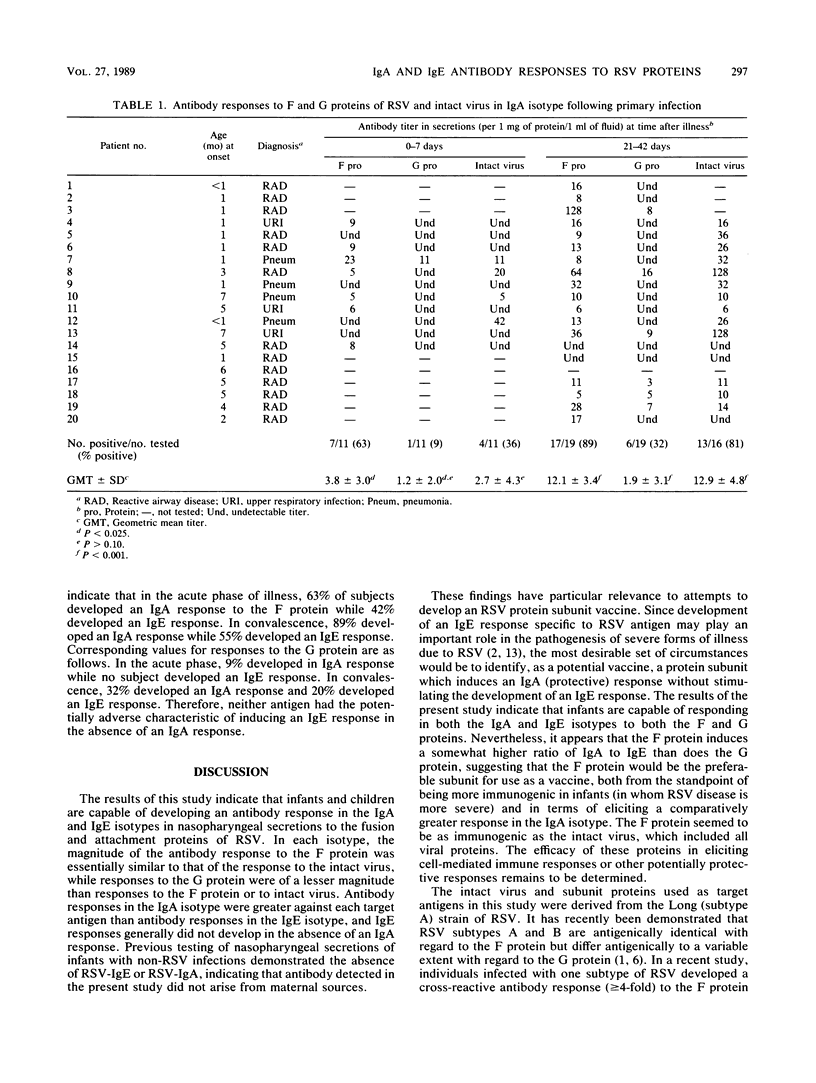Abstract
We studied the antibody response to the fusion (F) and attachment (G) proteins of respiratory syncytial virus and to purified intact virus in the respiratory secretions of 29 infants and children. The goal of the study was to determine whether the immune response to either of the glycoproteins occurred predominantly in the immunoglobulin A (IgA) as opposed to the IgE isotype, which would indicate that one protein subunit would be a better candidate as a potential vaccine. Antibody responses were determined by using an enzyme-linked immunosorbent assay with purified F and G proteins and sucrose gradient-purified intact virus as targets. Infants and children were capable of developing an antibody response in both the IgA and IgE isotypes to each target antigen. The magnitude of the antibody response to the F protein was essentially similar to that to the intact virus, while responses to the G protein were diminished in infants. A slightly more favorable ratio of IgA to IgE responses was observed against the F protein in comparison to the G protein. While neither protein subunit had the ideal characteristics of inducing an IgA response in the absence of an IgE response, the F protein seems to be a better candidate for use as a vaccine, on the basis of better IgA/IgE ratios.
Full text
PDF




Selected References
These references are in PubMed. This may not be the complete list of references from this article.
- Anderson L. J., Hierholzer J. C., Tsou C., Hendry R. M., Fernie B. F., Stone Y., McIntosh K. Antigenic characterization of respiratory syncytial virus strains with monoclonal antibodies. J Infect Dis. 1985 Apr;151(4):626–633. doi: 10.1093/infdis/151.4.626. [DOI] [PubMed] [Google Scholar]
- Bui R. H., Molinaro G. A., Kettering J. D., Heiner D. C., Imagawa D. T., St Geme J. W., Jr Virus-specific IgE and IgG4 antibodies in serum of children infected with respiratory syncytial virus. J Pediatr. 1987 Jan;110(1):87–90. doi: 10.1016/s0022-3476(87)80295-0. [DOI] [PubMed] [Google Scholar]
- Hendry R. M., Burns J. C., Walsh E. E., Graham B. S., Wright P. F., Hemming V. G., Rodriguez W. J., Kim H. W., Prince G. A., McIntosh K. Strain-specific serum antibody responses in infants undergoing primary infection with respiratory syncytial virus. J Infect Dis. 1988 Apr;157(4):640–647. doi: 10.1093/infdis/157.4.640. [DOI] [PubMed] [Google Scholar]
- Kaul A., Scott R., Gallagher M., Scott M., Clement J., Ogra P. L. Respiratory syncytial virus infection. Rapid diagnosis in children by use of indirect immunofluorescence. Am J Dis Child. 1978 Nov;132(11):1088–1090. doi: 10.1001/archpedi.1978.02120360044006. [DOI] [PubMed] [Google Scholar]
- Mills J., 5th, Van Kirk J. E., Wright P. F., Chanock R. M. Experimental respiratory syncytial virus infection of adults. Possible mechanisms of resistance to infection and illness. J Immunol. 1971 Jul;107(1):123–130. [PubMed] [Google Scholar]
- Mufson M. A., Orvell C., Rafnar B., Norrby E. Two distinct subtypes of human respiratory syncytial virus. J Gen Virol. 1985 Oct;66(Pt 10):2111–2124. doi: 10.1099/0022-1317-66-10-2111. [DOI] [PubMed] [Google Scholar]
- Murphy B. R., Alling D. W., Snyder M. H., Walsh E. E., Prince G. A., Chanock R. M., Hemming V. G., Rodriguez W. J., Kim H. W., Graham B. S. Effect of age and preexisting antibody on serum antibody response of infants and children to the F and G glycoproteins during respiratory syncytial virus infection. J Clin Microbiol. 1986 Nov;24(5):894–898. doi: 10.1128/jcm.24.5.894-898.1986. [DOI] [PMC free article] [PubMed] [Google Scholar]
- Murphy B. R., Graham B. S., Prince G. A., Walsh E. E., Chanock R. M., Karzon D. T., Wright P. F. Serum and nasal-wash immunoglobulin G and A antibody response of infants and children to respiratory syncytial virus F and G glycoproteins following primary infection. J Clin Microbiol. 1986 Jun;23(6):1009–1014. doi: 10.1128/jcm.23.6.1009-1014.1986. [DOI] [PMC free article] [PubMed] [Google Scholar]
- Murphy B. R., Prince G. A., Walsh E. E., Kim H. W., Parrott R. H., Hemming V. G., Rodriguez W. J., Chanock R. M. Dissociation between serum neutralizing and glycoprotein antibody responses of infants and children who received inactivated respiratory syncytial virus vaccine. J Clin Microbiol. 1986 Aug;24(2):197–202. doi: 10.1128/jcm.24.2.197-202.1986. [DOI] [PMC free article] [PubMed] [Google Scholar]
- Walsh E. E., Brandriss M. W., Schlesinger J. J. Purification and characterization of the respiratory syncytial virus fusion protein. J Gen Virol. 1985 Mar;66(Pt 3):409–415. doi: 10.1099/0022-1317-66-3-409. [DOI] [PubMed] [Google Scholar]
- Walsh E. E., Schlesinger J. J., Brandriss M. W. Purification and characterization of GP90, one of the envelope glycoproteins of respiratory syncytial virus. J Gen Virol. 1984 Apr;65(Pt 4):761–767. doi: 10.1099/0022-1317-65-4-761. [DOI] [PubMed] [Google Scholar]
- Ward K. A., Lambden P. R., Ogilvie M. M., Watt P. J. Antibodies to respiratory syncytial virus polypeptides and their significance in human infection. J Gen Virol. 1983 Sep;64(Pt 9):1867–1876. doi: 10.1099/0022-1317-64-9-1867. [DOI] [PubMed] [Google Scholar]
- Welliver R. C., Wong D. T., Sun M., Middleton E., Jr, Vaughan R. S., Ogra P. L. The development of respiratory syncytial virus-specific IgE and the release of histamine in nasopharyngeal secretions after infection. N Engl J Med. 1981 Oct 8;305(15):841–846. doi: 10.1056/NEJM198110083051501. [DOI] [PubMed] [Google Scholar]


